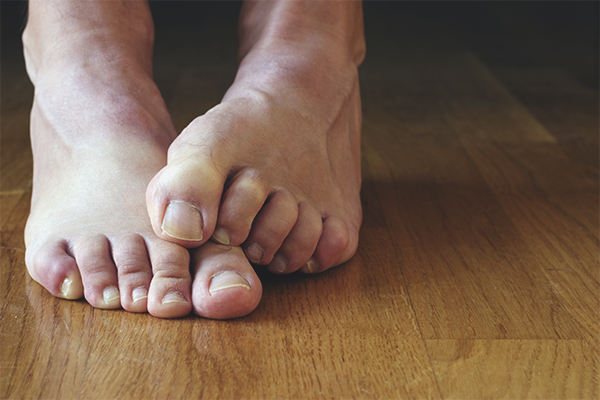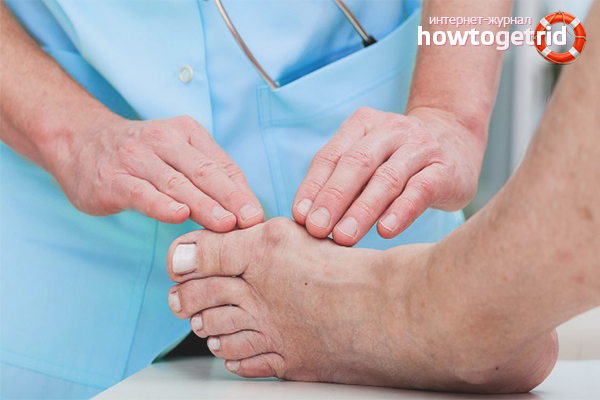The content of the article
The bone on the big toe (Hallux Valgus) or halus valgus is the biomechanical destruction of the joint of the big toe, caused by various factors. The disease is expressed in damage to the structure of cartilage tissue, accompanied by a deviation of the metatarsal bone to the outside and the formation of a bulge, similar to a lateral growing bone. A bump gives a lot of inconvenience, ranging from discomfort ending with the inability to wear shoes. However, Halus valgus is successfully treated and, if you go to a doctor in time, there will be nothing left of the "lump".
How does Hallux Valgus
Deformation of the big toe occurs at any age in both sexes. Teenagers and especially women are subject to the problem. According to the degree of joint damage, the disease develops in 3 stages:
- Initial stage. Metatarsus deviates no more than 15 degrees in relation to the other bones of the foot. When walking, there is tension, aching pain in the phalanges of the fingers. The bump is almost invisible, but in the place of its appearance reddening of the skin and the appearance of corn are observed. At the first stage, it is worthwhile to start treatment in order to forget about the problem as soon as possible.
- The second stage. When it is metatarsal bone deviates by more than 20 degrees, while the second toe rises above the rest. The bump has significant dimensions. Inflammatory processes in joints torment, the foot swells, natoptyshs are formed.
- Third stage. Plusphalangeal composition is affected. Not only bones are deformed, but the whole foot as well. All fingers have a different angle of inclination. Habitual shoes become cramped and uncomfortable, the foot flattens out.
What does the advanced stage of valgus deformation result in?
The bump on the big toe gives a lot of inconvenience. Unable to wear shoes that you like. On the shoes, heeled shoes can be forgotten. A lump leads to the appearance of corns, which are the site of infection in the blood.Over time, the foot also undergoes deformation, and this leads to more serious problems. Among them are the following:
- Chronic bursitis. This inflammation of the periarticular bag, in which the articular fluid accumulates. The tissue around the joint swells, increases in size.
- Traumatic tendovaginitis. The tendons of the foot are inflamed, the ankles swell, the person experiences pain while walking, and a crunch is heard when the joint moves.
- Deutschland disease. The march fracture, which is characterized by restructuring of the metatarsal bones, caused by exorbitant loads on the foot (difficult transitions, wearing uncomfortable shoes). The bone structure changes, it becomes compacted, the metatarsal bones are displaced relative to each other.
Why there is a bone on the thumb
- Flatfoot. In this pathology, the foot bones are initially located incorrectly, creating conditions for the deviation of the metatarsal bones.
- Congenital abnormalities. Dislocation of the foot, hip joint, etc.
- Pregnancy. The woman's center of gravity changes, the load on the toes increases.
- Overweight. The greater the weight, the greater the load on the foot.
- Osteoporosis.In this disease, the bone structure becomes porous, the joints become deformed.
- Adolescence. At the age of 9-10, there is a sharp growth of the bones of the foot, and in a 10-year-old girl the size of the foot can reach 38 in size with a height of 152 cm. This causes the deviations of the bones of the foot relative to each other.
- Injury. Any injury to the leg leads to smaller injuries, including the appearance of a bump on the thumb.
- Great physical exertion. Professional athletes (athletics, football, cross-country skiing) often have bones on their thumb.
- Inconvenient shoes. Hallux Valgus contributes to the development of wearing shoes with heels above 5 cm with a narrow nose.
How to get rid of the bone on the thumb
There are various methods of getting rid of the bumps on the toe. If the bone does not bulge much, then you can do self-medication. If Hallux Valgus is accompanied by severe pain, swelling of the foot, bloody calluses and corns, immediately contact an orthopedist. You should not let the disease take its course, for the sooner the treatment starts, the less painful it will be.
Surgical treatment
Surgical intervention is used in advanced cases when conservative treatment no longer helps.
- Chevron osteotomy or Austin operation. With this type of operation, the first metatarsal bone of the big toe is sawn in a V-shaped manner near the head, the excess bone is removed, the articular capsule is cleaned and placed in the desired position. The bones are fixed in the correct position with screws. After the operation a long rehabilitation period passes. The first months the patient walks in special shoes. 100% recovery of foot activity is observed 9-12 months after surgery.
- Ostemia of the base of the first metatarsal bone according to Lapidus. The operation consists in rigid fixation of the metatarsal bone with the first sphenoid bone. Fixation is done with bolts or metal plates. This type of surgery is performed on young people with hypermobility of the joints.
- Ostemia of the base of the first metatarsal bone according to the Strain. In this case, a bone-implant is attached to the sphenoid bone, with which the metatarsal bone is fixed in the correct position.The disadvantage of the method can be considered a very long healing process.
- The Watermann technique involves the complete replacement of the affected joint by transplanting healthy cartilage instead of deformed.
- C-shaped osteotomy avoids finger shortening and keeps the bone intact.
- The resection arthroplasty is performed on the joints affected by arthrosis and involves the replacement of silicone or metal implants.
Wearing special locks
They are used in cases of mild deviation of the metatarsal bone. The clips are easy to use, the joint is securely fixed during movement, the fingers are placed anatomically correctly. They should be worn from 2-3 months to six months, until the problem of the protruding bone is solved. Created special day and night correctors that are suitable for people of all ages.
ValuFix bus is a hinge device developed by orthopedists to reduce the load on the bones of the big toe. The bandage does not rub the leg, the porous pad protects the fingers and fixes them in the anatomically correct position,and the straps securely fasten the valgus splint to the foot. The size of the device is universal, the tire is used by both young people and the elderly.
Corrective tire Valgus Pro has flexible gel pads on the bones of the foot. The protruding bone is completely covered by a silicone corrector, without causing discomfort when wearing shoes. The advantage of Valgus Pro is that the tire has no hinges, so it can be worn with shoes. With regular wearing, the bone comes into place in 3-4 months.
Silicone Corrector Altus Pro to stop the degenerative destruction of cartilage. The device reliably fixes a portion of the foot that is subject to curvature, pressing a deformed finger against it. Proofreaders are recommended by orthopedists, both for eliminating a protruding bump, and for a speedy recovery in the postoperative period.
The elastic retainer Valgus Plus is completely invisible when wearing shoes and sandals. Soft silicone protects the skin of the foot from the formation of corns, abrasions and calluses. Hypoallergenic material does not cause irritation and diaper rash. The corrector perfectly fixes the fingers in the correct position, it is possible to do sports and dancing in it, and also to wear at night.
The use of therapeutic creams and ointments

- Cream Cone-STOP Shark Fat. Contains shark oil and noble laurel extract, helping to relieve inflammation and speed up the regeneration of damaged cartilage tissue. The cream is used three times a day, putting it on the bulging bone. The first results are visible in a month.
- Cream ValgusStop Lab Emancy. It has in its composition an extract of alpine flower arnica, which has regenerating properties. Corn oil is rich in phytosterols, relieves foot edema. Caffeine stimulates regenerative processes. The cream helps relieve pain, relieves bone in the early stages.
The sooner you are engaged in treating a protruding bone on the leg, the sooner positive results will appear. Also, timely treatment will relieve the painful operation, which has a long recovery period and serious potential complications. The best solution is to wear silicone clips.
Video: how to get rid of the bones on the leg












To send